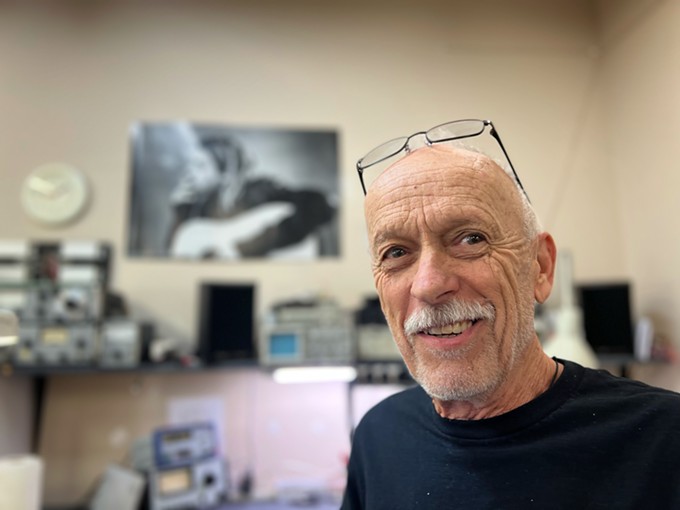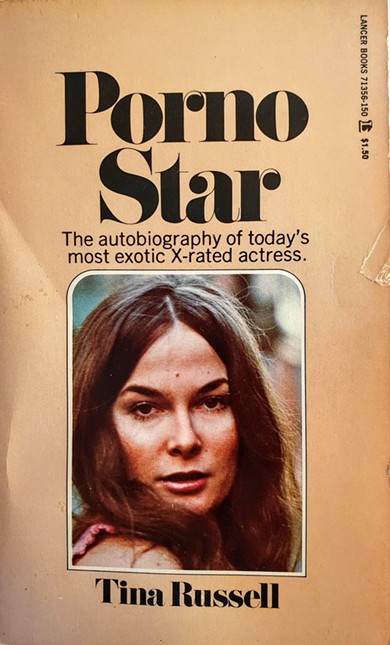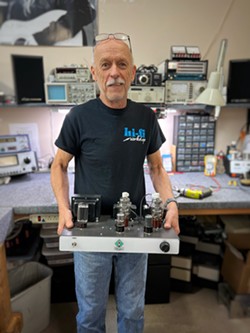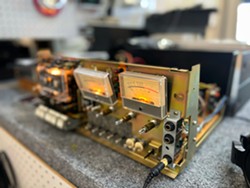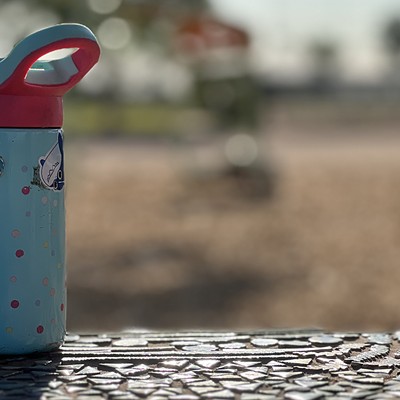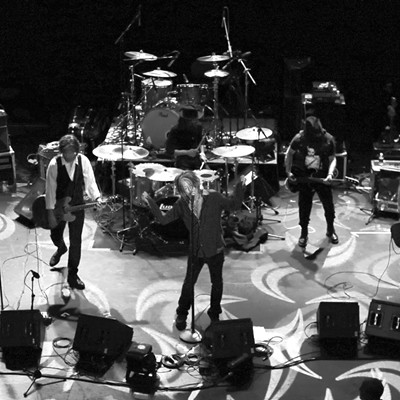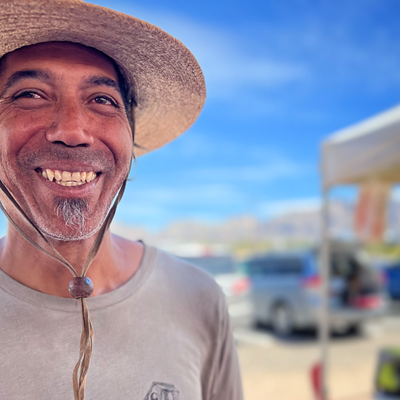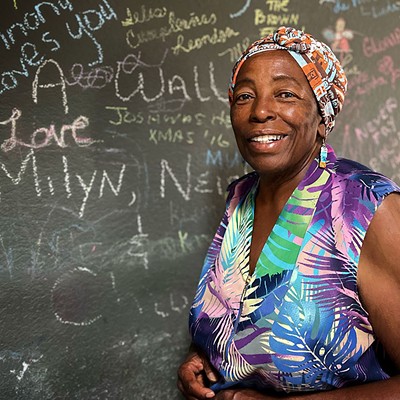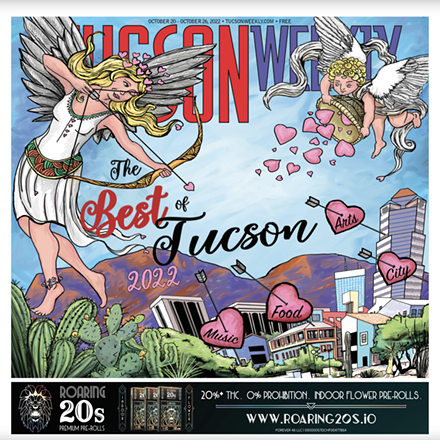It is a couple dudes, an odd couple, really. The owner, John Mintzer, and his sole employee, Justin Miller. They’re behind the storefront’s main room, hunched over pieces of home stereo gear. An action image of Kurt Cobain hangs high above, keeps eye. Each in a separate, orderly workspace outfitted with tools, sprays, soldering guns, magnifiers, harmonic distortion measuring machines and other gadgets boasting fetching VU meters. Maybe a customer will stroll in, break the peace and pace, the sort of mutual lazy exhilaration in their work.
The lighted, windowless back mini-warehouse area, divided by shelved stacks of stereo equipment, smells faintly of the inside of an old analog TV set. Squint and ditch Cobain and it could be the ’70s or ’80s; the HiFi Workshop, tucked in behind a Somali-food restaurant in central Tucson, seems to exist free of time, but nostalgia is palpable in the vintage stereo components in the little showroom for sale. It is where you might wait for something to happen, though you’d never know it.
In such moments it is easy to discover things about people, sometimes in the opening minutes. Spindly shop owner Mintzer steps around from his workbench, introduces himself. Grey mustache, blue t-shirt and jeans, seasoned face, and eager so his voice is never flat. He looks his age, 67, but doesn’t show it. Soon we’re talking his life, hitting on pivotal beats like smoking weed at 12, his kid pirate radio station, running away from his Pennsylvania home and hanging in the Village at 14, his older, trailblazing porn-star sister, who helped usher in the American sexual revolution, and her tragic early death, and, finally, how audio gear saved his life.
* * *
It wasn’t all cake as sole sibling of porn actress Tina Russell (born Linda Mintzer), decades before porn ubiquity, the easy-access Only Fans pages, countless free porn sites, multi-millionaire porno players. Needless to say, this stuff was taboo, and illegal, when Linda began in 1970, doing live sex shows and 8 mm loops, working with, among others, the Times Square porn king Marty Hodas.
The siblings were born in working-class town Williamsport, Pennsylvania. Catholic raised, Dad was an old-school functioning alcoholic, come home from long days and let go. Drink all weekend. A WWII vet, Army Air Corps Radio Operator, a respected electronic engineer for Sylvania. Then there was their stay-at-home mom, who had an 8th-grade education. The old man listened to country, Johnny Cash, Porter Wagoner.
“My parents never talked about anything personal,” John says. “I found out my dad had a hard life when he was younger. Once I woke up when I was 7 or 8, and our house was on fire from his cigarette. I’d have to sneak up and pull lit cigarettes out of his hand when he was passed out.”
John and Linda were close, though she was seven years older. She was smart, an engaged straight-A student, and artistic, shy and beautiful. She worked as a Candy-striper volunteer in Williamsport hospitals, keen to become a nurse or social worker. Both attended catholic schools.
Big sister Linda’s intellectual curiosity was boundless, and she turned John on to music and her rock ’n’ roll records, art and ideas, pot and wine, and Greenwich Village in the days of Nam and Stonewall riots, Dylan and Ginsberg. “She said, ‘I’m Expanding your mind beyond Williamsport.’ It started when I was in 7th grade.”
Linda made her way to the big city after high school in ’66. After fits and starts at a few universities (at one point she dropped out of NYU while studying psychology) between Williamsport and Manhattan, Linda met and married an older photographer named John Sanderson, a pre-AIDs, open marriage. Her dad thought he was a creep. In short, the couple decided to perform in sex work, changed their names and appeared in countless scenes together, and she performed with many other men.
A ’71 New York crackdown on porn saw the couple move to Peru for a year, where they lived in a tent, and she learned Spanish and studied the country’s history. Upon returning to New York Linda penned an autobiography, the long out-of-print Porno Star, released in 1973 on Lancer, known for its paperback science fiction and fantasy releases.
Images of Linda in the ’70s show a kind of X-rated Crystal Gayle, the hippie-boho spirit, the innocence-tinged sexual tension and forever half-lidded stare, the fall of her long dark hair. In those days only specific women ever generated that kind of attention, in any field. By the early ’70s, John’s sister was the biggest name in porn films. (Several of those early experimental sexploitationers employed arthouse trope imitations of Warhol and Fellini mixed with explicit sex.) The forgotten 35-mm film Not Just Another Woman from ’74, in which Linda plays a nun, is still considered one of the most ambitious, best X-rated films ever. Stars like Harry Reems and activist/sexologist Annie Sprinkle called Linda the world’s “first porn star,” and adored her on-screen and off.
Linda’s porn vision was to make artful statements of love and mix truthful explicit sex in worthy story-driven films. In Porno Star, she wrote persuasively of the struggles of getting such “pretty fuck films” made. She did nationwide book signings. Her movies and book found their way to Williamsport, and mom and dad were stunned. “My dad basically disowned her,” John says. “But they did see each other after. I think he kind of just blocked it all out.”
John was probably a senior in high school when he first saw his sister’s sex work. Others tried to shame him. But, he thought, this is my sister, this is what she wants to do.
“She wasn’t ashamed,” he says. “I really respected that; I was proud of her for doing what she wanted to do, and standing out. And it never upset me, the first time I saw any of her movies. It was kinda weird, it was my sister. I went along with friends to a drive-in, seeing her up there and my friends going, ‘oh, wow, she’s amazing.’”
Linda took pride in her career, kept scrap books, embraced with joy and gusto her sex work in film. But the movies were getting worse, far from the nascent filmmaking thoughtfulness that drew her in. She’d often turn down work if it didn’t suit her. Soon her husband left her for a 17-year-old girl. Linda was devastated. She hit the bottle and prescription pills, bloated and became anorexic. Her appearance suffered and the roles dried up. In 1981, she flew out to San Diego with her female partner to hang with John, who had moved west to work as a tech at an audio chainstore. He was shocked at her appearance. Last off the plane and in a wheelchair, she rolled out sickly and emaciated. One of the first things she said to John was she needed to get a drink. “I was devastated,” he says.
A few days later she was in the hospital dying. Her insides decayed.
“She was swollen up like a balloon,” John says. She squeezed his arm and begged him to get her out of there. He stood there helpless. She died of alcoholic liver disease, pancreatitis, starvation from anorexia, self-destruction and heartache.
“My mother was pretty heartbroken, but my dad rationalized it, saying, ‘that’s what happens when you don’t take care of yourself.’ That’s how they were.”
“When my sister was dying she had this look of total fear,” John adds. “Being so afraid and so alone.”
He saw the same look on his father’s face when he died of cancer the next year. “I told myself I do not want to die like this.”
* * *
John’s employee Justin steps outside the shop for a smoke, returns, and is testing out gear, booming the Jackson 5, vintage rhythms to color vintage memories and sadnesses. Justin, in his 40s, a musician, nurses a lifelong fascination with electronics, had a previous job booking shows at Tucson venue The Flycatcher before it was demolished. He doesn’t say much beyond hilarious and smart observations. He listens.
“He’s the story here,” Justin says, pointing to John.
John picks up his fascination with electronics, its genesis.
He’d dig through his dad’s electronics magazines in bed at night. He was soldering at 6 years old. By 12 he was building good-sound component stereos from discarded console stereos and found pieces. “My dad would come home from the bar with an old radio or something somebody wanted to fix and he’d give it to me.”
The kid built an illegal pirate home radio station, broadcasting his sister’s records around the block. His county-music listening, electronics-whiz Dad taught John a lot, it was his redemption as a father. John’s parents hardly instilled in their children any kind of roadmap to negotiate life, and the kid had his big sister’s teaching for a world beyond Williamsport.
He’d run away from home. Once, he hitchhiked with a buddy from Williamsport to New York City, hung around a few days and then split to Jacksonville, Florida. He was 14. He wound up in jail for vagrancy. He used someone’s draft card as a fake I.D. until cops discovered his true identity. They phoned his dad, who said, “Keep him awhile. See if he wants to come home.”
“It was pretty traumatic in that jail getting pushed around by somebody who killed somebody,” John says.
Growing up, John was terrible at sports, “always the last one picked” on the schoolyard. He gave up on the kids in his old neighborhood, and soon they called him “hippy.” After high school he spent a year studying electronic engineering at Penn State, and bailed.
While staying with his sister in New York, John got a break, hired as a tech of sorts at Todd Rundgren’s storied Secret Sound studio in Manhattan, in a loft belonging to producer/Utopia keyboardist Moogy Klingman. It is where Rundgren recorded ’73’s A Wizard A True Star and ’74’s Todd.
Whenever Todd was in the studio his then-girlfriend, model Bebe Buell, was always on his lap, he says. “And I remember Bette Midler recording there, she came up to my chin. She gave me a hug, that’s the way she was.”
John was too self-doubting to have no job security. He lasted six months at Rundgren’s studio. “It didn’t work well for me,” he says. “I wanted to be up all night with them doing coke, deep down I wanted to live the New York studio life, but there was no structure, no schedule.”
That’s when he moved to San Diego, at 21, for a secure stereo tech job, stayed five years, until just after his sister died and returned home to help care for his father until he passed. He opened a stereo store in his hometown and that was it.
John may have stumbled onto electronics as a kid, opened successful businesses in several states, branched out to car alarms and cell phones. Along the way he became his father. “I was mainly a beer drinker, had a refrigerator with a keg in it. I always said I’d never be like him. I had children. I couldn’t do that.”
John married, divorced, remarried and divorced the same woman. Has two biological children, with whom he is close, and in 2020 he became a grandpa. At one point, he went back to school, earned a degree in accounting, and worked white collar. It didn’t last but a few years. “Ninety percent of my life was self-employment, I never felt rewarded the other way.”
He’s been sober 30 years, smokes a little weed now and then, talks about his bad back and knee pains, the years of crawling though small places installing audio. He laughs of once installing a full disco in a mansion owned by Rockefeller kin, inserting a subwoofer under the guy’s bed.
The certified electronic technician is an audiophile in that he has long had a heightened awareness to the science of actual sonics and vibrations, and how most artists intend the music to sound. He could talk days about switch-mode power supplies, driver boards and transformers, digital to analog converters — he is a master at repairing, modifying, building audio gear — but this stuff runs deeper than sound and mechanics. It’s about the actual touch, how the electronics work. It’s the inner-noise cancelling stuff, the internal conversations with self. “It is a meditation,” he says. “It’s one of the few things in life that eased all the tormenting in me.” He pauses. “It saved me.”
Several years ago, he retired in Florida (“had enough of that place”). He refitted a van into a rolling studio apartment, hit the road for two years discovering, spent months doing volunteer work with rescued dogs in New Mexico. He arrived in Tucson, worked for his friend-owner of the now-gone Stereo Hospital. He fell in love with Tucson, couldn’t stay retired and opened this place three years ago with about $20k. He lives in an eastside apartment. He doesn’t need much, doesn’t want much. He’s been offered jobs at high-end audio manufacturers over the years and he turned them all down.
He knows audio is science-based, and the gobbledygook used to describe the high-end stuff puzzles. So, he and another partner in Florida began building stereo tube amps and preamps they dubbed Cathodyne (Cathodyne.com), some of which are available at Hifi Workshop. It’s high-end audio that is remarkably inexpensive and simple, because, John says, there is no marketing, no staff, no factory. The components are constructed of love. He services true high-end stuff too, and digital; reference audio pieces sit on the shelf ready for pickup.
In a world where most music is consumed through crap-sounding phones and laptops, you’d think Hifi Workshop would be doomed. Hardly. They’re slammed. In a Southwestern town centered in blue-collar sensibilities, where luxury items like a new 100k stereo is beyond anyone’s means, this guy, like his Hifi Workshop showroom, is mostly vintage, part nostalgia, part niche. It works, like the classic analog stuff he sells, used and restored.
John’s sister Linda taught him decades ago how the music matters. He got it. “Some music caused this feeling inside of me, Bowie, Simon & Garfunkel, Stones. We all resonate to a certain frequency, when you hit those, those harmonics, it hits something deep inside. I don’t want to leave that place ever.”
Brian Smith's collection of essays and stories, Tucson Salvage: Tales and Recollections of La Frontera, based on this column, is available now worldwide on Eyewear Press UK. Buy the collection in Tucson at Antigone Books, 411 N. Fourth Ave. You can also pickup his collection of short stories, Spent Saints (Ridgeway Press).

